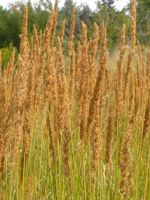Mon-Fri 9am - 5pm Mountain time
Slimstem Reedgrass vs Hairy Golden Aster
Calamagrostis stricta
Heterotheca villosa
CUSTOM GROW
NOT AVAILABLE THIS SEASON - MIGHT RETURN
Slimstem Reedgrass is a native perennial bunchgrass commonly found in damp meadows, wetlands, and along streams and lakeshores. It thrives in wet, nutrient-poor soils and shows some tolerance to saline conditions. Typically a bunchgrass, it can also spread by rhizomes to form colonies, making it well-suited for soil stabilization, riparian zone planting, and wetland restoration projects.
Slimstem Reedgrass provides valuable cover for small animals and birds, and its dense growth can even serve as nesting habitat for waterfowl in wetland areas. Its seeds offer forage for wildlife, while the tall stems and floral spikes add texture and visual interest to the landscape.
Hairy Golden Aster is a native perennial wildflower known for its clusters of bright yellow, daisy-like blooms. They bloom from mid-summer into fall, providing late-season colour and a valuable nectar source for pollinators, including a variety of bee species.
Flowers mature into fluffy seed heads and can self-seed readily. Removing spent blooms helps manage their spread, but some people will choose to leave a few seed heads to provide food for birds. Hairy Golden Aster grow in bushy clumps, tolerates poor sandy soils, and once established, are among the most drought-tolerant wildflowers. They are well-suited for pollinator gardens, restoration, naturalization, and xeriscaping projects.

